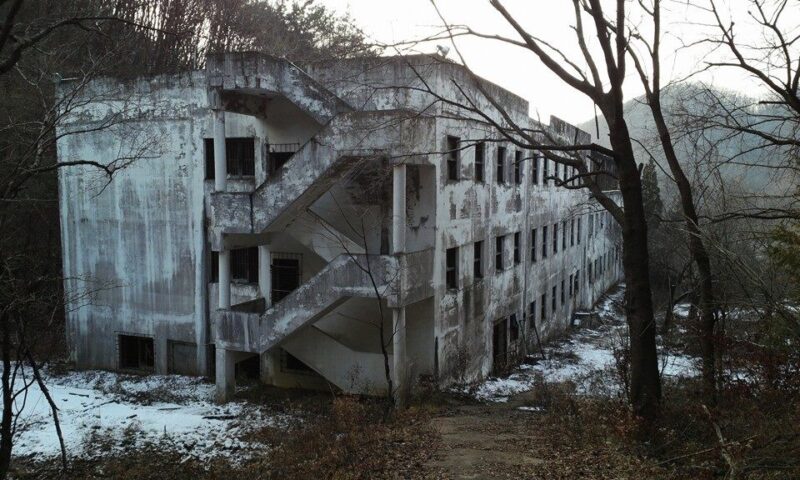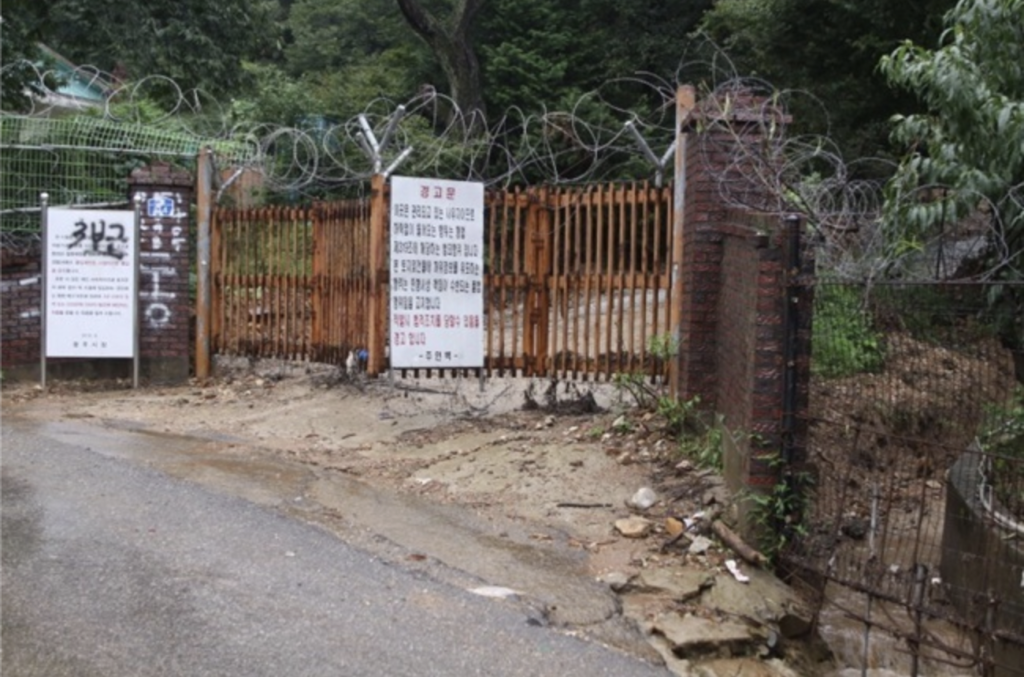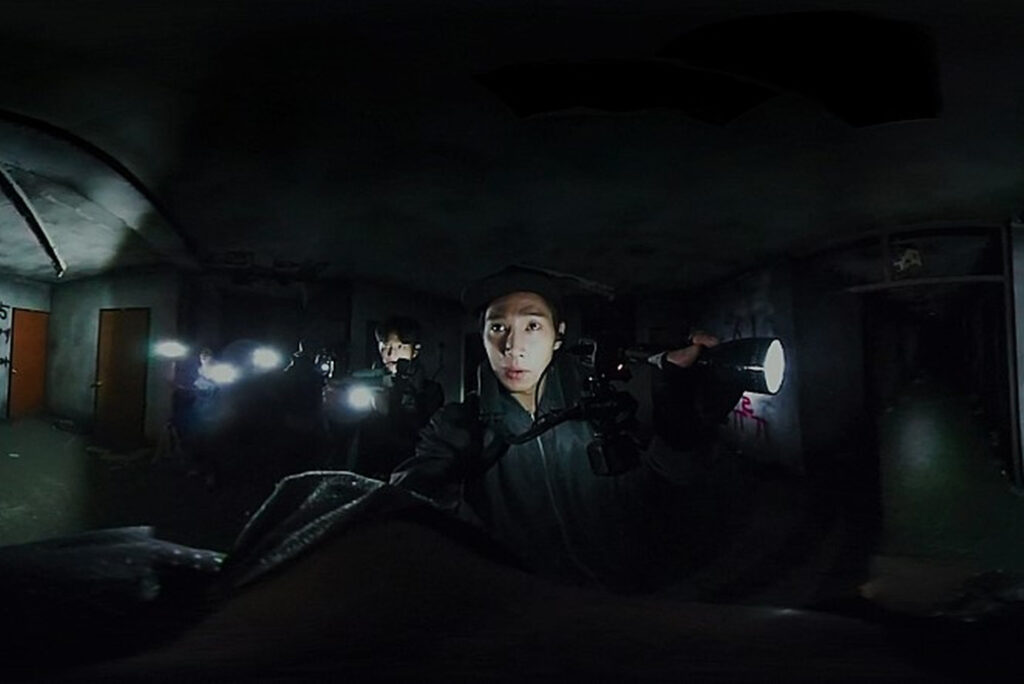The Haunted Gonjiam Psychiatric Hospital: Gone But Not Forgotten

In 1982 the Gonjiam Psychiatric Hospital (or 곤지암 정신병원 / Gonjiam Namyang Neuropsychiatric Hospital) was established outside Gyeonggi-do, South Korea by a Mr Hong. The original building was just over 11,000m² and spread across three floors. Sometime during the early 1990s, an additional two buildings were added, which increased the size by another 500m². A short time later in July 1996 the hospital closed and was left abandoned and unmaintained for over two decades.
Nefarious rumours began to spread about the hospital’s closure and ghost hunters and urban explorers began flocking to the spooky site in droves. Gonjiam Psychiatric Hospital quickly gained a reputation as one of the top three haunted buildings in South Korea. But until an article was published by CNN in 2012 featuring Gonjiam as one of the world’s most terrifying locations, the hospital had mostly maintained its ghostly reputation domestically.
Sources discussing the history of Gonjiam and the fate of the hospital aren’t incredibly common on the English side of the internet, so the majority of research for this article was done using Korean sources. However, specific dates and versions of stories and events vary so much from source to source that it’s worth taking some information with a grain of salt. Enjoy Gonjiam Psychiatric Hospital for the creepy legacy it left behind, but don’t consider it a perfect reflection of the history of psychiatric hospitals in South Korea.
The Urban Legend and Alleged Hauntings

So what’s all the fuss about? What makes this particular abandoned hospital so terrifying?
It helps that the entire building looks like a living, breathing ‘haunted insane asylum’ trope: collapsed ceilings, long echoing corridors, doors that shut on their own, and patient rooms littered with old mattresses and forgotten personal items. From the outside, the main building is a concrete block with a zigzagging exterior staircase and windowless black holes peering into the eerie interior. The building just looks haunted. And what do creepy abandoned buildings need? A ghost story, of course. And it didn’t take long for one to begin making the rounds.
According to legend, many patients at Gonjiam died mysteriously, forcing the hospital to shut down permanently. Some believe the murders were being committed by the hospital owner who was accused of keeping the patients hostage. It’s said that the owner fled to America after the victims’ families and government authorities began investigating the unexplained deaths.
Another story says Gonjiam’s doctors and director were driven to madness while working alongside the mentally ill patients, which lead the director to end his own life. Some believe his suicide was caused by a ghost who possessed his body and drove him to the brink of insanity.
And the many other ghosts that haunt Gonjiam’s abandoned halls are the victims of the psychotic doctors and murderous owner. While the hospital is closed for the living, the former patients of Gonjiam are trapped forever in the place where they met their gruesome end.
A great ghost story, but is it based in any truth?



Photos Taken by ‘My So Called Creative Life’. Please visit their website here for a full walkthrough of their experience visiting Gonjiam and plenty of more photos!
The real reason for the hospital’s closure is much less exciting…
The hospital director didn’t commit suicide, nor was Gonjiam closed due to the mistreatment or murder of patients. Business at Gonjiam Psychiatric Hospital actually came to an end because of finances, not mad doctors. With the implementation of the Water Source Protection Act in South Korea, a new sewage treatment facility became a sudden legal required for the hospital. This caused a disagreement between the owner and the director over whether or not it was worth the financial strain to install a new treatment facility. While talks were ongoing in 1997 the elderly owner passed away and a new treatment facility was never installed, so the hospital remained closed. When the former owner’s son took over the property he neglected to maintain it and the hospital fell into disrepair.
As for the former hospital’s director, he was alive and well at the closing of Gonjiam and allegedly opened another psychiatric hospital in the province of Gangwon-do, east of Seoul.
Essentially, nothing about the legend surrounding Gonjiam Psychiatric Hospital is actually true. And a lot of the rumours seem to come from a South Korean television show called 이영돈 PD 논리로 풀다 (ENG: Solve with the logic of PD Lee Young-don), which had an episode featuring the reported hauntings at Gonjiam.
When a building looks as creepy as Gonjiam Psychiatric Hospital, it’s no wonder we let our imaginations run away from us. But for those who lived locally, the real horrors of Gonjiam had a more earthly source.
Ongoing Issues with Trespassing

Like many abandoned buildings around the world, Gonjiam Psychiatric Hospital suffered from a constant flow of trespassers. Security cameras, barbed wire, and notices threatening legal action (in both Korean and English) were added to the front gate in an attempt to discourage unwanted visitors. Security guards patrolled the site and Google Maps suspended Street View for the stretch of road in front of the main gate. But none of the deterrents worked, the draw of Gonjiam was simply too strong. If someone wanted to get inside, they were going to find a way.
While ‘insane asylums’ in popular culture are often found in creepy, isolated locations, Gonjiam’s main gate was located beside private residential properties. This meant the scariest part about living near the abandoned hospital wasn’t the ghosts, but the constant groups of strangers visiting the town at night. This understandably made the locals feel unsafe in their own homes and created unnecessary work for local police who received countless calls to investigate break-ins at Gonjiam.
And the release of the popular South Korean horror film Gonjiam: Haunted Asylum in early 2018 only increased domestic curiosity surrounding the hospital. While filming was primarily done at the Busan National Maritime High School (another allegedly haunted location), this didn’t stop trespassers from flocking in even greater numbers to Gonjiam. The release of the film also caused issues with the hospital owner who filed a lawsuit in an attempt to stop Gonjiam: Haunted Asylum from being shown in theatres. He claimed that rumours about the hospital’s unsavoury (and false) history were making it difficult for him to find buyers interested in the troublesome property. However, a Seoul court ruled in favour of the film and it was shown in theatres without further issue.
But after years of bitterness surrounding the property, the fate of Gonjiam Psychiatric Hospital was finally sealed once and for all.

Visiting Gonjiam Psychiatric Hospital today (know anyone with a time machine?)
Before you book your flight to Seoul, I have some unfortunate news: Gonjiam Psychiatric Hospital has been demolished. The demolition project took place on 28 May 2018, shortly after the release of the film, putting an end to Gonjiam as a pilgrimage site for ghost hunters.
According to a June 2018 article in The JoongAng, talks soon commenced regarding redevelopment of the site. Proposals included the construction of an industrial or villa complex, and there was even a proposal to turn the former hospital grounds into a horror attraction. However a real estate consultant turned the idea down saying “the horror theme park is not subject to review because it does not match the sentiments of the residents of Gonjiam.” It would have been cruel, after all, to continue the plight of the local residents even after the hospital had been demolished. In the end it seemed more probable that an industrial complex would be built due to permit restrictions.
However, a satellite view of the area on Google Maps from 2022 (see below) shows little or unnoticeable progress of any sort of development within the last four years. It appears as though Gonjiam Psychiatric Hospital is now no more than an empty field. As for the ghosts that walked it’s halls, perhaps they’ll one day find a new home in whatever future development inhabits the troublesome site.


Explore Gonjiam Psychiatric Hospital online
While Gonjiam Psychiatric Hospital may be gone for good, videos from curious visitors give a glimpse into just how creepy the abandoned hospital was before it’s demolition. If you’re feeling brave, I highly suggest the following three videos of Gonjiam. Just make sure to keep your lights on!
MeloCat, Hong Kong YouTuber
Watch her vlog ‘Creepy Abandoned Gonjiam Psychiatric Hospital‘ on YouTube
MeloCat and her friend take an alternate route through the mountain to enter the hospital property. Despite exploring during the day, the general atmosphere is very, very eerie. At one point they hear footsteps running towards them on the floor above. Was it a ghost or another urban explorer?
신태일다시보기, Korean YouTuber
Watch his vlog ‘철구와신태일 [곤지암정신병원 3대흉가 체험]‘ on YouTube
Two friends break into the hospital at night and explore the dark halls. At one point they seem to stumble upon what looks like chunks of human hair on the ground in one of the rooms. Due to the low visual quality of the video, it looks like a mini found footage horror film, which is exactly what I think they were going for. (No subtitles but they aren’t necessary to enjoy the creepy vibe!)
YOONSIWON, Korean Ghost Hunter/YouTuber
Watch his vlog ‘Gonjiam Mental Hospital in Korea: This is one of the scariest places in the world‘ on YouTube
Ghost hunter Yoon Si-Won gives a full tour of the hospital while exploring by himself at night. This is the most in-depth video I’ve seen of Gonjiam and includes the various patient and admin rooms, and bathrooms, as well as the roof and the basement.
Want more Creepy Korea? Check out the Curious Archive article on the terrifying Korean and Japanese Elevator Game to another dimension!
Sources and Additional Reading
[Please Note: Since there is little detailed information on Gonjiam Psychiatric Hospital on the ‘English’ side of the internet, I gathered the majority of my sources from Korean websites. I do not speak Korean so I used the auto translate option in Chrome to read the articles. If you’d like to read more about Gonjiam Psychiatric Hospital, I recommend using this feature to translate the Korean sources below.]
CNN – 10 of the freakiest places around the world
The JoongAng – 곤지암 정신병원 ‘철거’…”공포 테마파크 개발은 아니야” (ENG: Gonjiam Mental Hospital to be demolished… “It’s not a horror theme park development”)
Insight – ‘세계 7대 공포 장소’로 뽑혔던 곤지암 정신병원 근황 (ENG: Gonjiam Psychiatric Hospital, selected as one of the ‘World’s 7 Most Haunted Places’)
Kyeongin – ‘공포영화 모티브’ 괴담 낳았던 곤지암 N정신병원 건물, 철거 시작 (ENG: Gonjiam N Mental Hospital building, which gave birth to a ‘horror movie motif’ ghost story, begins to be demolished)
MK – 공포 피서족 ‘비명’에 시골마을은 ‘악몽’ (ENG: The rural village is a ‘nightmare’ to the feared refugee ‘scream’)
My So Called Creative Life – A Creepy Afternoon Alone in an Abandoned Hospital- Gonjiam Psychiatric Hospital
Naver – 곤지암 영화 이후 ‘곤지암 정신병원’에 생긴 일 (ENG: What Happened to ‘Gonjiam Mental Hospital’ after the movie Gonjiam)
Saigoneer – The Hair-Raising Experience of Exploring South Korea’s Creepiest Psychiatric Hospital
The Korean Bizwire – “Haunted” School Attracts Thrill Seekers
The Korean Times – ‘Exorcising’ an abandoned mental hospital
